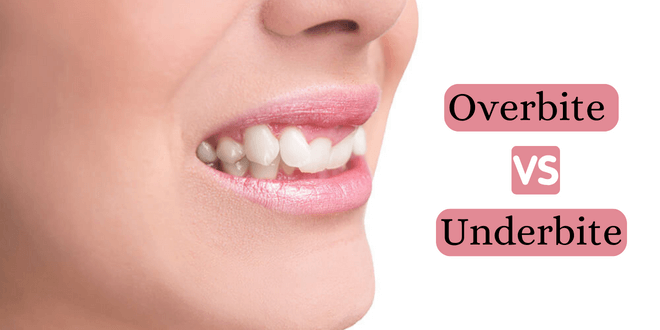The alignment of your upper and lower teeth defines your appearance and overall health. If your teeth are misaligned, you may face difficulties in doing tasks such as chewing and biting and your teeth may wear out or become crooked with time. The two most common malocclusions (misaligned bites) are overbites and underbites. Read this blog to know what is overbite and underbite and the difference between overbite and underbite.
Underbite vs Overbite
What is an Underbite?
An underbite is a condition in which your lower teeth extend beyond and over your upper teeth. It tends to be skeletal, meaning it is related to jaw growth. It occurs when there is a too-large lower jaw or too-small upper jaw.
How to Identify an Underbite?
Stand in front of a mirror and close your teeth. If the lower front row extends out in front of the upper row, you have an underbite. Your chin or lower jaw may also seem more prominent.
What Causes Underbite?
Underbites are generally genetic and develop from the skeletal traits you inherit from your parents. It can be because the lower jaw grew too much, the upper jaw not enough, or a combination of both. Other factors include –
- Oral habits such as thumb sucking, prolonged pacifier use, or tongue thrust that interfere with jaw growth
- Birth defects such as cleft lip and palate
- Facial or jaw trauma
- Jawbone tumors
What is an Overbite?
An overbite is a condition where the upper front teeth rest significantly forward of the lower front teeth when the jaw and teeth are brought together (when biting down). It occurs when the lower jaw is smaller or shorter than the upper jaw.
How to Identify an Overbite?
You can identify an overbite by looking in the mirror. You will see that your upper teeth partially or entirely cover your bottom teeth. In extreme cases, you may even feel your bottom teeth touching and irritating the roof of your mouth.
What Causes Overbite?
If your lower jaw is too small, you will have excessive overbite. It is generally genetic and thus cannot be prevented. It can also be caused by –
- Overused chewing muscles from habits like chronic teeth clenching and grinding or bruxism
- Missing lower back teeth, which can cause the bite to collapse
Treatment Options for Underbites and Overbites
While the misalignment of teeth can disrupt your quality of life, it is not permanent. There are various treatment options for underbites and overbites to help you improve your overall appearance and achieve optimum oral health.
1. Invisalign (Clear Aligners)
They are custom-made transparent trays that fit the shape and size of your teeth. They achieve the desired alignment within the treatment’s timeframe by guiding your teeth through incremental movements. They are transparent and unnoticeable and can be removed when you eat or brush your teeth.
2. Metal Braces
Metal braces were the traditional treatment for misaligned bites. They are bound together by an orthodontic wire and are attached to the teeth using dental adhesives. The teeth are slowly put in the ideal places by moving up the wire size every eight to ten weeks to put pressure on the teeth. Metal braces can be used to treat severely misaligned teeth. However, they require regular visits to the orthodontist for adjustments and checkups.
3. Retainers
They are not used to correct overbites or underbites but can help maintain your newly aligned bite once the treatment is over. Whether you go for metal braces or Invisalign, your orthodontist will provide retainers to keep your teeth in the optimum place.
4. Orthognathic Surgery (Jaw Surgery)
Jaw surgery may be required in severe cases of overbites and underbites. Treating misaligned bites in adults is more challenging as the jaw is no longer growing. However, this method is only recommended if the orthodontist finds that braces or aligners do not help with your teeth alignment issue. Jaw surgery focuses on realigning the jaw. It is a painless and safe procedure generally done under anesthesia. Although recovery from the surgery may take some time, it shows almost immediate results for overbites and underbites.
When it comes to overbite vs underbite, both require corrective action to keep your mouth healthy. The longer you wait, the worse the condition will get. So, act now to get a beautiful smile! Make and appointment today!

0 comments on “Overbite vs Underbite: Know the Difference”